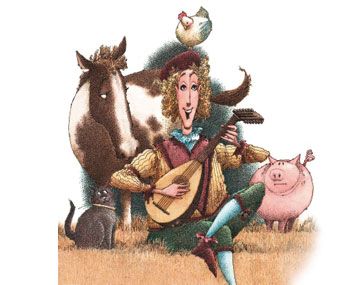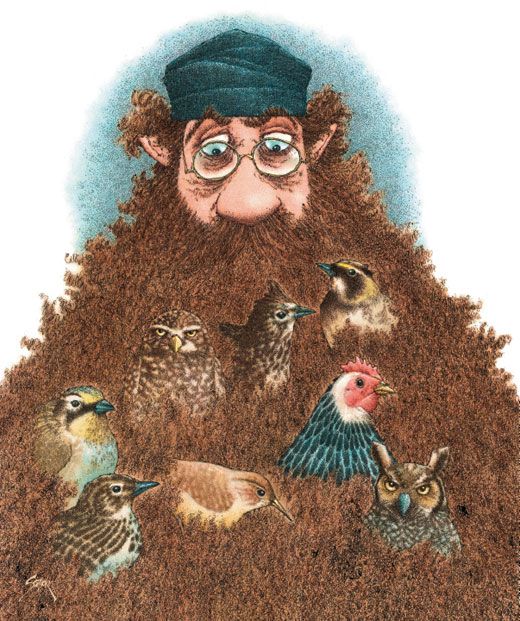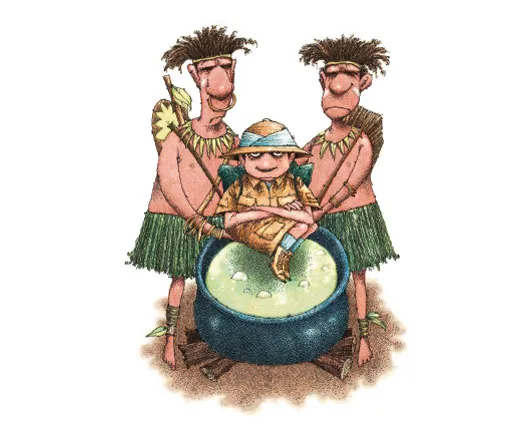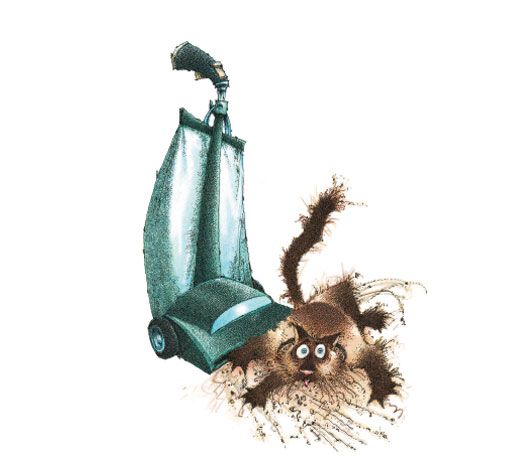The Limerick is Furtive and Mean…
From the Maigue poets to Ogden Nash, witty wordsmiths have delighted in composing the oft-risqué five-line verses
/https://tf-cmsv2-smithsonianmag-media.s3.amazonaws.com/filer/limerick_natives.jpg)
“Hickory, dickory, dock, a mouse ran up the clock. . . . ” so vivid is the imagery and so strong the rhyme and meter that even the most poetically impaired can supply the last lines to this charming bit of doggerel. It has enthralled children since its publication in 1744 and is the first poem I can ever recall hearing, rendered dramatically by my kindergarten teacher some 70 years ago. Like a lot of well-remembered poetry, it is a limerick.
In college, after I had read most of the important English, American and European poets, I returned to nursery rhymes and considered myself witty because I could recite Edward Lear’s “The Owl and the Pussycat went to sea. . . ,” as well as other of his short, punchy poems, such as: There was an old man with a beard Who said: “It is just as I feared! “Two owls and a hen, “Four larks and a wren, “Have all built their nests in my beard.”
It recently dawned on me—now that I am, myself, an old man with a beard (but as yet no larks)—that I have been exposed to an astonishing number of limericks since I first heard about the clockclimbing mouse. During decades of relatively casual encounters with the work of numerous poets and writers, the trail has been generously littered with these ubiquitous five-line verses. How did such a rinky-dink metric form manage to insinuate itself into the creative life of so many authors?
Take Lewis Carroll. When the wildly imaginative storyteller was not tutoring young people, working on Alice’s Adventures in Wonderland and attending to his voluminous correspondence, he delighted in tossing off descriptions of, for example, a young man who grew constantly shorter, while . . .
His sister, called Lucy O’Finner,
Grew constantly thinner and thinner;
The reason was plain,
She slept out in the rain,
And was never allowed any dinner.
It’s doubtful that the theatrical partnership of Gilbert and Sullivan would have maintained its long and enormously popular success in the absence of W. S. Gilbert’s propensity for limericks, which appear in so many of his lyrics, such as his courtship advice from the 1888 light opera, The Yeoman of the Guard, on page 94. But Gilbert was also well known for his quirky, non-rhyming limericks, designed to catch the reader off guard:
There was an old man of St Bees
Who was horribly stung by a wasp.
When they said: “Does it hurt?”
He replied: “No, it doesn’t—
It’s a good job it wasn’t a hornet!”
And, W. H. Auden, a brilliant poet whose literary corpus is marked by thoughtfulness and solemnity, seemed to find release in the humor of the limerick:
T. S. Eliot is quite at a loss
When clubwomen bustle across
At literary teas,
Crying: “What, if you please,
Did you mean by The Mill on the Floss?”
Limericks are essentially word puzzles in light verse, more often than not infused with sexual innuendo. Nobody wrote wittier ones than Ogden Nash, whose ingenious poetic playfulness complemented the form and who, as it happens, was born 100 years ago this month. Many know his “I would live all my life in nonchalance and insouciance, were it not for making a living, which is rather a nouciance.” But fewer readers may be acquainted with his take on the Middle Ages:
A crusader’s wife slipped from the garrison
And had an affair with a Saracen;
She was not over-sexed,
Or jealous, or vexed,
She just wanted to make a comparison.
In the course of a lengthy career writing science fiction stories, nonfiction and novels, Isaac Asimov published several volumes of what he called “lecherous limericks.” Some readers may remember his:
“On the beach,” said John sadly, “there’s such
A thing as revealing too much.”
So he closed both his eyes
At the ranks of bare thighs,
And felt his way through them by touch.
Among other notable writers who have delighted in the limerick are Mark Twain, Dante Gabriel Rossetti, Walter de la Mare, Aldous Huxley, Conrad Aiken and Alfred Lord Tennyson. Notability is not, however, a prerequisite. The following lyric may leap to mind even if its author, Thomas Moore, remains largely unremembered:
The time I’ve lost in wooing,
In watching and pursuing,
The light that lies In women’s eyes
Has been my heart’s undoing.
Moore, an early 19th-century Irish poet who lived most of his life in London, wrote about his native land with great feeling, which brings us to the limerick’s Irish connection. It’s a reasonable assumption that any verse with this name must have emerged from Ireland’s LimerickCity. Well, nearly. As the Irish might say, “It did, and it didn’t.”
To settle the matter, I traveled to the heart of limerick-land, the tiny village of Croom (pop. 1,000), ten miles south of Limerick City. Just a few steps from a short stone bridge over the Maigue, a swift river that features prominently in the origins of the limerick, I met two local historians, Mannix Joyce and Sean de Creag. Both are former schoolteachers and county council officials. De Creag, who lived most of his life in Croom, now sells newspapers and magazines; for the past 58 years, Joyce has written a weekly column on local history for the Limerick Leader.
De Creag led us down the road and through the open door of a pub. “This is the snug where the ladies of the village would come for their toddies,” he said as we ordered glasses of the local cider. The windows of the sunny room looked out onto a farmyard with cackling chickens and a sleek dark rooster mounted on the top rail of a fence in the middle distance.
During the three-hour tutorial that followed, I became increasingly aware of the rhythmic sounds surrounding us: the chickens outside the window, the Maigue murmuring through the village, dogs barking. The cock on the fence rail, with uncanny timing, frequently punctuated the last line of an especially clever limerick with his piercing call.
Joyce arrived with a handful of scholarly materials, explaining to my dismay that few Irish people today walk around with limericks on the tips of their tongues. Even so, limericks remain deeply entrenched in Irish popular culture. In the early 20th century, limerick contests were taken so seriously that furnished homes and lifetime annuities were awarded to winners.
Historical events often figure in Irish limericks. Joyce told me about an outspoken Irish archbishop in Melbourne, Australia, who went around championing the Irish fight for freedom. “When the English learned he was coming this way,” Joyce said, “they feared he would stir up trouble. So the British Navy was dispatched to capture him on the high seas and take him to England. In the end, his capture proved a fiasco, largely because of the archbishop’s unflappable nature.” Joyce recited poet Beda Herbert’s 1971 limerick:
There was a high cleric named Mannix,
Monumentally cool amid panics;
A fleet he could fool,
He played it so cool—
An iceberg among the Titanics.
It is widely (and probably incorrectly) thought that Edward Lear invented the limerick. He certainly made it popular. The Oxford English Dictionary first defined the word limerick in 1892, four years after Lear’s death. But as O. E. Parrott makes clear in the opening pages of The Penguin Bookof Limericks:
The limerick’s birth is unclear:
Its genesis owed much to Lear.
It started as clean,
But soon went obscene.
And this split haunts its later career.
To underscore this point, de Creag thereupon rolled out a local limerick. In the timeworn tradition of limerick recitation, he said, it had been “told to him by someone”:
A sporting young lady of Croom,
Led life to the full, I’d assume.
A poet by day,
And by night a good lay,
Thus from bed to a verse, to her doom.
“He’s being modest,” said Joyce, smiling broadly. “I happen to know that my friend here sent that limerick to Norway where it was a great success. It was translated and published in Norwegian before returning to Ireland. We’re talking about an international poetic medium, you see.”
The five-line verse probably originated from the limerickmakers of Croom, known as the Maigue poets, who flourished in the 18th century. They were schoolteachers, priests and self-styled persons of letters, living within 20 miles of this southwestern Irish village. Their gatherings at inns and taverns were called poets courts, to which new members were invited by “warrants” to drink, recite, and often sing, their verses.
Their revels were a latter-day form of the ancient Irish bardic schools, conducted in Greek, Latin and Gaelic. Aware of official efforts to supplant Gaelic with the English language, the Maigue poets were protective of their native tongue, one reason that their poetry was little known until the middle of the 19th century, when English translations began to appear.
The Maigue poets apparently possessed prodigious memories, passing limericks and other poetry from one generation to the next orally, an ability that seems to live among Irish village poets to this day. “I once interviewed an elderly lady,” Joyce said, “who could create excellent poetic descriptions of small towns from a few details people would give her. She didn’t write them but spoke spontaneously. More than a year later—she was now well past 80—I visited her with a printed copy of the long poem she had first spoken to me. I offered to prompt her, but she would have none of that. ‘Oh no,’ she told me. ‘I remember it entirely.’ And she did. It was letter-perfect.”
One of the Maigue’s first-known limerick-makers was tavern owner John O’Toumy, who was born a few miles from Croom in 1706. Of his own business practices, he bemoaned:
I sell the best brandy and sherry,
To make my good customers merry.
But at times their finances
Run short as it chances,
And then I feel very sad, very.
To which Andrew McCrath, another Maigue poet, was quick to respond:
O’Toumy! You boast yourself handy
At selling good ale and bright brandy,
But the fact is your liquor
Makes everyone sicker,
I tell you that, I, your friend, Andy.
The verse form John O’Toumy and Andrew McCrath helped foster became an energetic dimension of the Irish cultural landscape. Centuries before step-dancing swept across our stages, sailors from around the world landed in Cork and made the short journey north to the taverns of Limerick. And while there’s no concrete evidence to suggest how the limerick spread from continent to continent, the following explanation is offered by an anonymous bard:
The sailors returned to their ships
To contemplate thousands of trips,
Then set sail on the breeze
With short rhymes up their sleeves,
And limericks from Croom on their lips.





